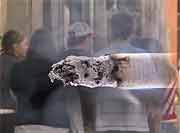
SUNDAY, June 24 (HealthDay News) — Exposure to secondhand smoke seems to be associated with an increased risk of obesity and type 2 diabetes in adults, according to a new study.
The findings are based on data from more than 6,300 adults who participated in the U.S. National Health and Nutrition Examination Survey from 2001 to 2006. The researchers found that, compared to nonsmokers, those exposed to secondhand smoke had a higher rate of type 2 diabetes and a higher body-mass index (BMI), a measurement that takes into account height and weight.
In addition, compared to nonsmokers, people exposed to secondhand smoke also had a higher measure of insulin resistance (which can lead to type 2 diabetes), higher levels of fasting blood sugar, and a higher hemoglobin A1c reading (a measure of blood sugar control over the past three months).
Diabetes rates were similar for people exposed to secondhand smoke and smokers, and both groups had a higher hemoglobin A1c than nonsmokers. However, people who were current smokers had a lower BMI than nonsmokers, the findings showed.
The study was scheduled for presentation Sunday at the Endocrine Society’s annual meeting in Houston. The data and conclusions of research presented at medical meetings should be viewed as preliminary until published in a peer-reviewed journal.
While the study uncovered an association between secondhand smoke exposure and obesity and type 2 diabetes risk, it did not prove a cause-and-effect relationship.
“The association between secondhand smoke and type 2 diabetes was not due to obesity,” study co-author Dr. Theodore Friedman, chairman of the department of internal medicine at Charles R. Drew University in Los Angeles, said in an Endocrine Society news release.
“More studies are needed to show whether secondhand smoke is a cause of diabetes,” Friedman added. In addition, “more effort needs to be made to reduce exposure of individuals to secondhand smoke,” he concluded.
More information
The U.S. Centers for Disease Control and Prevention has more about secondhand smoke.

